- Egypt Tours Price

A Red Sea Travel Guide
Discover the ultimate red sea travel guide, dive into the wonders of the red sea.

Book Your Luxury Egypt Tour
Why the Red Sea Should Be on Your Travel List
Explore unique attractions, immerse yourself in local culture.

Swimming in the Red Sea: What You Need to Know
Stay safe in the waters.

Find the Best Swimming Spots

Plan Your Trip: The Best Time to Visit the Red Sea
Choose the perfect season, local events and festivals.

Travel Tips: How to Get to the Red Sea
Understand travel requirements, navigate your journey, uncover top red sea destinations, discover hurghada.

Explore Sharm El Sheikh
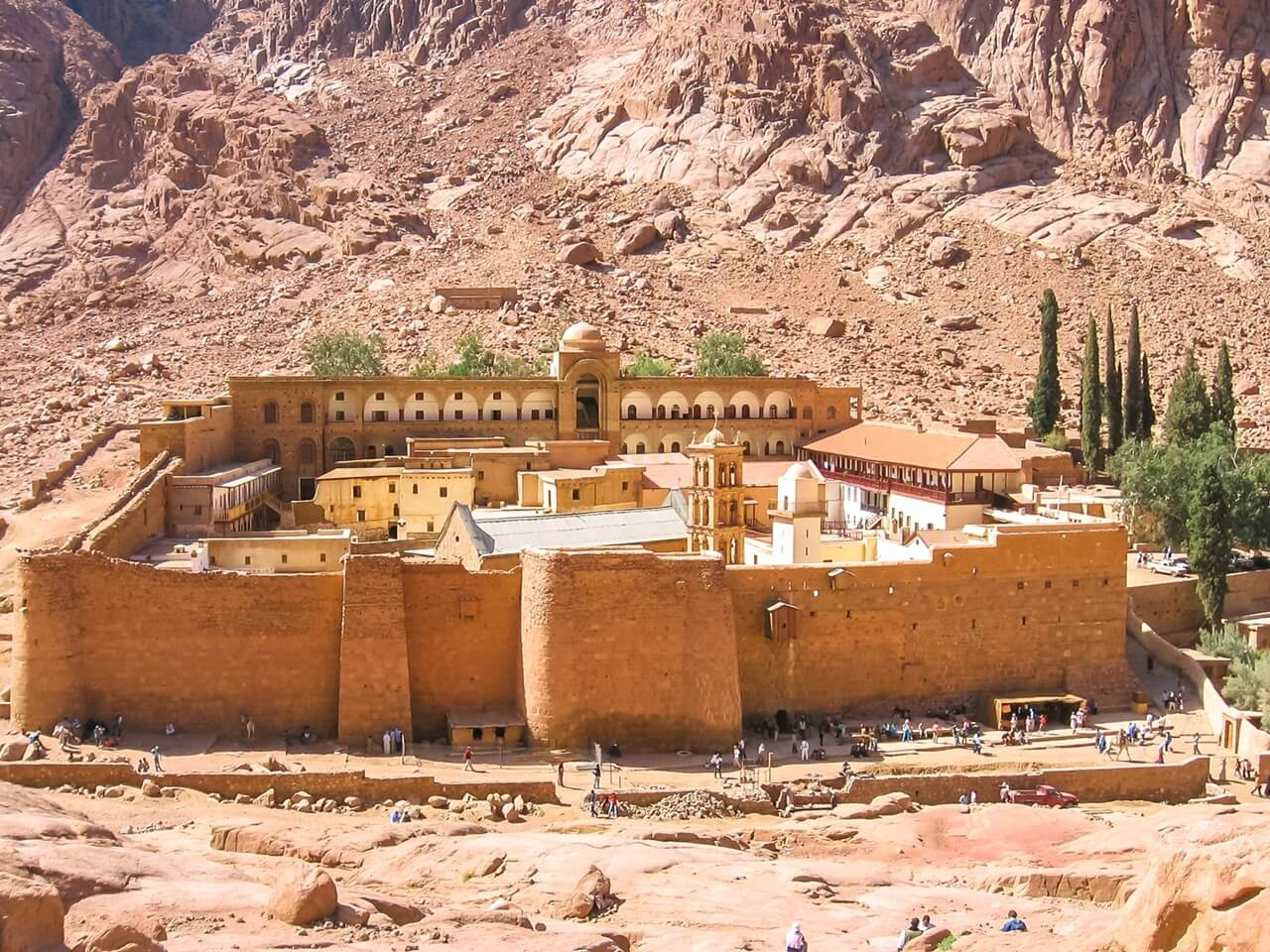
Dive into Marsa Alam

Adventure in Dahab

Experience Top Activities in the Red Sea
Dive and snorkel in crystal waters.

Enjoy Water Sports

Embark on Desert Adventures

Explore Hidden Gems of the Red Sea
Discover lesser-known spots, experience unique adventures.

Unearth Historical Insights
Follow ancient trade routes, explore biblical references.

Master Practical Travel Tips
Choose the right accommodations.

Savor Local Cuisine

Stay Healthy and Safe
Red sea travel guide round up.
- Breaking news from Egypt
- Inside Egypt life
- Ancient Egypt & Egyptology
- About modern Egypt
- Egypt highlights
- TOP 10 Egypt
- Insider tips for a trip to Egypt
- Eat like a real Egyptian
Safety Updates on Visiting Egypt During the Hamas-Israel War
- May we help you? Customer service 24 hours a day:
- +34 91 524 33 66
- [email protected]
- Points of interest
Egypt’s Red Sea is a jewel of clear, warm waters with a paradise of coral reefs and the sun bathing its shores . It is located in the Indian Ocean, between Africa and Asia, and is visited every year by thousands of tourists attracted by water sports.
Introduction
The Red Sea has more than 2,200 km of coastline south of the Sinai Peninsula, with a width of more than 300 km and many cities built around its beaches. The best known are Hurghada and Sharm el-Sheikh .
But the charm of the Red Sea does not end here but continues centuries back through the history of mankind, as with everything in Egypt. The whole world knows the Red Sea without having visited it, since it was the scene of one of the most important biblical episodes in history: the one that narrates how Moses parted its waters for the Jewish people who were escaping from the yoke of Pharaoh.
Because of the small thermal variation of the water throughout the year and because it is the warmest sea in the world, the Red Sea is perfect for scuba diving or snorkeling . and see exotic and colorful species: fish, mollusks, corals and other typical exponents of marine flora and fauna. A wide variety of aquatic life that can be seen at temperatures between 20 and 40 degrees.
Red Sea must-see destinations
It is one of the is the most important Egyptian seaside resorts located on the shores of the Red Sea, with colorful seabeds and crystal clear waters . The third most populated in Egypt and one of the newest. Founded in the early 20th century by fishermen as a small village that grew into a large city. It stands out for its beaches, dunes and good food, as well as for its aquarium with thousands of species and for the Gubal Strait, where the best reefs of Hurghada are found and also the remains of many important shipwrecks, which makes it an ideal place for diving.

Sharm el-Sheikh
Famous for its transparent waters for diving or snorkeling , Sharm el Sheikh is one of the main cities of the Red Sea coast and treasures a rich fauna of colorful fish and impressive corals. And one of the great bastions of Egypt’s coastal tourism. It has a rich heritage of mosques and bazaars, as well as restaurants to eat good fresh fish and seafood. Its coastline is home to wonderful coral reefs and the sunsets from any point of the city are very famous.

Berenice and Hamata
They are two cities on the Red Sea coast very close and with different charms. Berenice owes its name to Ptolemy II Philadelphus, a historic city that was an important port in antiquity and still maintains the profile of a port city. Hamata is a smaller town and ideal for diving and also, due to its characteristic winds, ideal for kitesurfing.
Tips for first time divers
Many people choose to dive for the first time in the clear waters of the Red Sea. And although you will receive prior instruction from a specialist, these tips for diving for the first time will be of great help to you.
- Choose the right day. For your first dive, it is best to have good weather because weather conditions can affect your dive.
- Ask everything to the monitor. Don’t have any doubts before getting into the water, remember that you won’t be able to communicate with anyone down there.
- Breathe and relax. You carry an oxygen cylinder on your back, so you can breathe normally and nothing will happen to you. Don’t let your nerves get the better of you once you’re down.
- It is looked at and not touched. The sea is a natural heritage of mankind, so try not to touch anything. Even for your own safety, think that there are species that you do not know and that you do not know the effect they can cause if you touch them.
- Climb carefully. When you want to ascend, do it slowly and slowly, because a sudden ascent can affect your lungs due to the sudden change in pressure. The measure of how you rise is the column of bubbles you emit on each exhalation of air: your rise should be slower than the bubbles.
- Check your equipment. Before a dive it is vitally important that you check your equipment, making sure that your wetsuit and goggles fit properly and that your oxygen tank is working properly.
How to get to the Red Sea
- Hurghada. The city is connected to Cairo through an international airport that also connects it with some of the main European cities such as London, Rome and Paris.
- Sharm el Sheikh. You can reach the city by direct flight from Cairo or Luxor (there is no direct flight from Aswan) and from these cities and many others by train or bus.
- Marsa Alam. You can arrive by plane from Cairo, Luxor or Sharm el Sheikh.
- Berenice and Hamata. It has an international airport recently opened in Berenice and has flight combinations with Cairo, Luxor and other areas of the Red Sea. Between one city and another you can move by private car, as they are very close.
Other articles that may interest you...
Egypt’s Red Sea is a jewel of clear, warm waters with a paradise of coral reefs and the sun bathing
Nubia Museum
The Nubia Museum is one of the least visited museums in Egypt but one of the country’s most fascinating attractions,
Utilizamos cookies y otras tecnologías
Selecciona la configuración de privacidad.
The Red Sea
Book your individual trip , stress-free with local travel experts
Select Month
- roughguides.com
- red-sea-coast
- Travel guide
- Itineraries
- Local Experts
- Travel Advice
- Accommodation
Plan your tailor-made trip with a local expert
Book securely with money-back guarantee
Travel stress-free with local assistance and 24/7 support
Absolutely loved it, the service was seamless from the first pickup from the airport to the return drop-off. The local guides were excellent, knowledgeable...
The beauty of the landscape and an excellent climate are obvious reasons for the Red Sea’s ever-increasing popularity, especially as a winter-sun destination. Its coast runs for 1,600 km (1,000 miles) in a southeasterly direction from Suez. For most of its length, beautiful but desolate limestone and granite mountains border the coast, with range rising upon range, their shades of purple harmonising with deep-blue skies and blue-green seas. But this once pristine coast is changing fast. Most of the coastline has been sold to developers and many largescale tourist projects, from the basic to the luxurious, are newly built or underway.
Travel tips for visiting the Red Sea Coast
What to do on the red sea coast, best places to stay, how to get around, how many days do you need, what is the best time to visit, how to get to the red sea coast, travel ideas for egypt.
Created by local experts

The Best of Egypt
Explore the history and culture of Egypt and its ancient rulers on this trip throughout the country. Start and end in Cairo and make your way down to Luxor, Aswan and Abu Simbel. Instead of domestic flights, you will hop on luxurious sleeper trains for your journey.

Cairo & a luxurious Dahabieh sailing cruise
Explore Egypt at a leisurely pace on board a dahabieh, a traditional sailing ship. In Cairo, visit the Egyptian Museum of Antiquities, and in Giza, the pyramids; cruise to world-renowned sites alongside lesser-known treasures, such as Luxor’s tombs, el Kab and Gebel Silsileh’s Temple of Horemheb.

A Nile Cruise in Egypt
Experience Cairo with the pyramids of Giza and the Egyptian museum before flying to Luxor to board your Nile cruise. Highlights include Karnak temple, Valley of Kings, Hatshepsut temple and an optional visit to Abu Simbel. Spend your last night in fascinating Cairo.

Five Star Egypt
A tour through the ancient wonders of Giza, Cairo, Luxor, and Aswan. Start and end your trip in beautiful Cairo, exploring the surroundings before heading down to Aswan: you will spend four nights on a luxurious Nile cruise ship, discovering ancient sites such as Abu Simbel.

An introduction to Egypt
Marvel at the pyramids in Giza, explore busy Cairo, sleep on a luxurious sleeper train and explore more temples close to Luxor. This itinerary is fast-paced, with several nights in Cairo at the beginning and end, enabling you to see many fascinating sights in Egypt.
Apart from the area east of Cairo , the transition from the green Nile Valley to the Rea Sea is abrupt. Suddenly the lush cultivated land gives way to stony wilderness, in which rocks rise up in extraordinary formations, reminiscent of the pyramids and Sphinx, the sand blows and spills, and there is hardly a sign of human life for hundreds of miles.
To get to the coast from Cairo, avoid the heavily congested Cairo–Suez highway and follow route 75 to Ain Sokhna, 134km (83 miles) southeast of Cairo and 56km (35 miles) south of Suez. Effectively the nearest seaside resort to the capital, this is a popular year-round getaway for wealthy Cairenes thanks to a strip of swaying date palms, white sand and clear green-blue sea.
Ride the Porto Sokhna Telepherique, a cable car that runs 1km (0.6 miles) from the Porto Sokhna Beach Resort up to the highest hill behind town. There are terrific views of the Gulf of Suez and the sea liberally strewn with tankers converging on the canal. South of Ain Sokhna, the rocky skirts of the North Galala Plateau come right down to the edge of the sea. The drive here is spectacular.
Planning a trip to Egypt? Perhaps our local experts can help you plan your dream trips!

St. Anthony monastery in Eastern desert, Egypt © Shutterstock
From bedding down at El Gouna, Egypt’s most luxurious resort, to kite-surfing at Safaga, these are the best things to do along the Red Sea coast.
#1 Explore the hermit Monastery of St Anthony
About 25km (15 miles) west of Zaafarana, in the rugged hills at the foot of the South Galala Plateau and looking out over the desolate Wadi Araba, stands the Monastery of St Anthony, the 4th-century Christian hermit whose temptations were enthusiastically illustrated by painters of the Renaissance.
The monastery was founded by Anthony’s followers after his death in AD 356, and is often regarded as the first monastery in the world. The oldest building in the compound is the church of St Anthony, which is adorned with murals from the 13th century onwards.
A path from the west side of the monastery leads to a steep staircase to St Anthony’s cave, where the saint lived as a hermit until the age of 105. His life is considered to be the inspiration for monasticism in Egypt , although others credit his contemporary, St Paul.
#2 Find peace at the Monastery of St Paul
Retracing the road through Zaafarana, it is an hour’s drive to the monastery of Anthony’s contemporary, St Paul, tucked into a fold of the Red Sea Mountains. Smaller, more dilapidated and more remote, the Monastery of St Paul the Hermit sees fewer visitors.
St Paul (AD 230–342) was the earliest known hermit but, when he was visited in his cave at the age of 113 by St Anthony, St Paul recognised him as being spiritually his superior. St Paul’s cave is in the church of St Paul, which also contains his remains.
#3 Stay at El Gouna, Egypt’s most luxurious holiday village
The resort of El Gouna, 21km (13 miles) north of Hurghada, is Egypt’s most luxurious purpose-built holiday village. Cairene businessman, Samih Sawiris, bought the plot of land with the intention of building a few holiday homes for family and friends, but before long his business instincts got the better of him, and he seized the opportunity to create something unique in Egypt.
At its conception in 1989, El Gouna was originally planned as a self-contained community, but it is now almost considered a town in its own right (albeit a privately owned one).
Today, it has a hospital, an international school, a private airport, three yacht marinas, a mosque and a Coptic church; even the local football team, El Gouna FC, plays in the Egyptian Premier League.
Gardens, canals and several man made lagoons add to the impression of peacefulness, and there are numerous swimming pools and several good beaches too.

Bungalow on a canal. El Gouna, Egypt, Red Sea © Shutterstock
#4 Sit back and chill at Hurghada
In recent years, what was a small sleepy fishing village, Hurghada (Al-Ghardaqah), 420km (250 miles) south of Suez, has grown into a booming resort town – the largest on the Red Sea coast. The town has a large range of accommodation, from basic hotels catering for backpackers to up-market resorts.
A long strip of holiday villages continues to spread further south and has now reached a long way past the airport. Many of these villages, which rival each other for splendour, the size of their pools and the number of rooms, are operated by international four- and five-star chains.
Read all about this place on our page about Hurghada .

Hurghada El Mina mosque, Egypt © Pixabay
#5 See the Roman quarry camps of the Eastern Desert
In Pharaonic times the Eastern Desert was a source of gold and other precious metals, ornamental stone and other building materials, which contributed greatly to the wealth and prestige of the pharaohs and were later coveted by Assyrians, Persians, Greeks and Romans.
Thousands of prisoners in chains were used for the extraction of these riches and many died in the process. The gold was arduously mined and smelted, and both granite and limestone were quarried and transported to Thebes for the construction of temples and other monuments.
The Romans established permanent quarrying camps in the mountains, the ruins of which are visible from the road between Hurghada and Safaga. They were particularly partial to the purple stone known as porphyry, which comes from Mons Porphyrites (Mountain of Porphyry) below Gabal Abu Dukhan (Father of Smoke) and which is accessed along Wadi Umm Sidri (4x4 vehicles only, with local guide ).
#6 Head to Safaga for wind- and kite-surfing
Some 62 km (39 miles) south of Hurghada, Safaga is primarily a port town that exports phosphates. During hajj, ferries operate from here transporting Muslims in the Nile Valley across to Saudi Arabia en route to Mecca. Cruise ships also dock here, although passengers are immediately whisked off on shore excursions to either Luxor or Hurghada.
But a small tourist area has nevertheless developed at the northern end of the bay with a choice of hotels; almost permanently windy, the town is particularly popular with wind- and kite-surfers as well as divers to the nearby reefs.
Safaga lies 165 km (103 miles) from the Nile town of Qena to the west, on an excellent tarred road. From Qena it’s another 70km (44 miles) south to Luxor, so this is the fastest and most logical route from the Red Sea resorts to the Nile Valley – although expect police checks along the way.

© Shutterstock
#7 Go diving at Marsa Alam
The fishing town of Marsa Alam has now been overtaken by tourism. It has been the focus of some frenzied construction over the last decade, with several luxury resorts and an international airport for charter flights.
The main drive behind it all is good diving and snorkelling. The development just outside the airport is Port Ghalib; with its hotels, villas, restaurants, shops and activities, it has grown into a southerly version of El Gouna.
A popular excursion from Marsa Alam is to Wadi el Gemal National Park, which was designated a protected area in 2003 and is located 40km (25 miles) further south, covering both land and marine areas. Dive operators take clients to the coast and to five offshore islands for excellent diving and snorkelling, while the terrestrial section can be visited on 4x4 Jeep safaris that include a camel ride and lunch or dinner with the Bedouins
The Red Sea area of Egypt is a popular destination for beach lovers and divers, so when it comes to choosing the best area to stay in the Red Sea , there are a few key options to consider.
Hurghada is a bustling city with a wide range of accommodations , from budget-friendly hostels to luxury resorts.
Sharm El-Sheikh
The region's busiest area, Sharm El-Sheikh, has a wealth of hotels , namely luxury accommodations and upscale retreats and resorts.
Dahab is a laid-back and budget-friendly option, offering a range of affordable accommodations and a more relaxed beach-vibes atmosphere. It's particularly popular among backpackers and those looking to escape the crowds of other Red Sea destinations.
Browse the best hotels in the Red Sea .

Marsa Alam turtle © Shutterstock
The Red Sea Coast is stunning, so the best ways to get around this beautiful region are those that let you slowly take it all in. Here's how to get around.
One of the most affordable ways to get around the Red Sea Coast is by bus. Many bus companies operate in the region, providing reliable and affordable transportation options. Buses are an excellent way to travel between cities and towns, and they are often air-conditioned and comfortable.
Taxis are readily available in most cities and towns along the Red Sea Coast, providing a convenient and reliable mode of transportation. It is advisable to negotiate the fare before getting into a taxi.
The Red Sea is a significant waterway, and traveling by ferry is a popular mode of transportation. High-speed ferries shoot between Sharm El Sheikh and Hurghada.
By microbus
Microbuses are a popular and affordable mode of transportation on the Red Sea Coast, particularly for short distances. They ply certain routes and can be flagged down on the street but aren't as handy to get between towns.

Church at eastern egyptian desert in St Paul monastery © Shutterstock
You will need at least 5 to 7 days to explore the Red Sea Coast in Egypt. This will give you enough time to visit popular destinations such as Hurghada, Sharm El-Sheikh, and Marsa Alam.
If you plan to visit only one or two cities along the Red Sea Coast, you may be able to complete your trip in 3 to 4 days. However, if you wish to engage in activities such as scuba diving, snorkeling, or exploring the local culture, plan to stay longer.
In Hurghada, for example, you can spend a few days exploring the city's beaches, water sports, and other activities. You can also visit the nearby Giftun Island, a protected marine reserve, and explore its coral reefs and abundant marine life.
If you're interested in water sports like scuba diving, snorkelling, or swimming, the best time to visit the Red Sea is during the spring and autumn months of March to May and September to November, respectively. During these months, the sea temperature is warm and comfortable, ranging from 22°C to 28°C (71°F to 82°F), and the weather is mild with low humidity levels.
If you prefer to enjoy the beaches and other outdoor activities, the summer months from June to August can be a good time to visit, but it can be very hot and humid, with temperatures often exceeding 40°C (104°F). It's essential to stay hydrated and avoid the midday sun during this time. However, this is the peak season, and you can enjoy a lively atmosphere with lots of events and festivals.
The winter months from December to February can be a bit chilly, with temperatures ranging from 16°C to 22°C (61°F to 72°F), but it's still possible to enjoy outdoor activities, and you can avoid the crowds and get lower prices during this time.
Find out more about the best time to visit Egypt .
There are several ways to get to the Red Sea coast in Egypt depending on your location and budget. Below are the easiest ways.
The fastest way to get to the Red Sea coast is by flying into Hurghada or Sharm El Sheikh airport. Both cities have international airports that serve major airlines from around the world.
If you're on a budget, public buses are available from major cities like Cairo, Luxor, and Aswan. The journey can take several hours, but it's an affordable option for those who want to save money.
Hiring a private taxi is a comfortable and convenient way to get to the Red Sea coast. It's also a popular option for those who want to explore the region at their own pace. Agree on a fee with the driver before setting off. Your hotel should be able to help you find a good drive.
Find out the best ways to get to Egypt .
Discover more places in Egypt

- South of Hurghada
The Rough Guides to Egypt and related travel guides
In-depth, easy-to-use travel guides filled with expert advice.


Find even more inspiration for Egypt here

Planning your own trip? Prepare for your trip
Use Rough Guides' trusted partners for great rates
written by Rough Guides Editors
updated 03.05.2023
Ready to travel and discover Egypt?
Get support from our local experts for stress-free planning & worry-free travels.
- Travel advice
- Where to stay
- Skip to main content
- Skip to after header navigation
- Skip to site footer
EgyptTravelBlog.com
This form is for demo purposes only. Use whatever form/email/optin plugin you’d like.
* We don’t do spam, just the latest news. Sign up today and get our top stories delivered straight to your inbox.
Where to Go on Egypt’s Red Sea
The Red Sea is the long and relatively narrow body of water that lies between the northeast coast of Africa and the Arabian peninsula that is bordered by Egypt, Israel, Jordan, and Saudi Arabia, Yemen, Djbouti, Eritrea, and Sudan. Despite some of those countries being red flags for war and conflict, the Red Sea is a remarkably peaceful and conflict-free body of water.
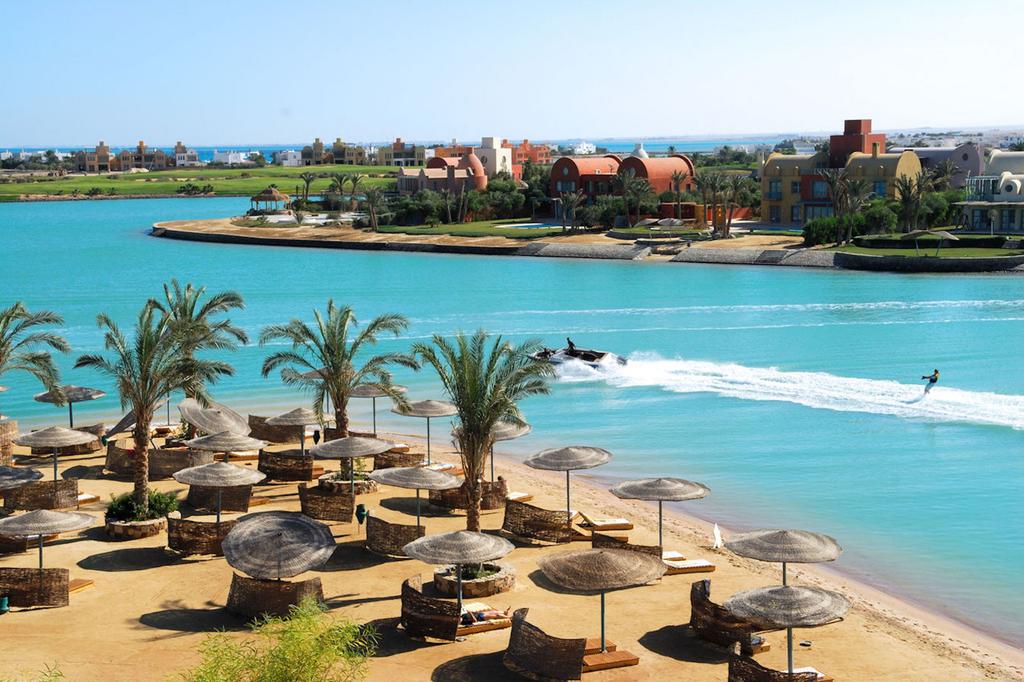
Here, though, we’re obviously going to focus on Egypt. When we refer to Egypt’s Red Sea coast with respect to tourism, we’re really talking about two main areas – the eastern coastal portion of Egypt on the African continent, or what I call Egypt proper, and the eastern coast of the Sinai Peninsula. Now notice I left off one major area, namely the Sinai Peninsula’s western coast, and that’s simply because there’s nothing there, or at least nothing worth visiting.
The Red Sea coast of Egypt proper and the eastern coast of the Sinai, including the tip of the peninsula, are where all of the action is when it comes to the Red Sea. And actually, that applies to the whole Red Sea. As mentioned earlier, eight countries border the Red Sea but Egypt is really where it’s at when it comes to the best and most accessible resorts. Jordan and Israel each have tiny slivers of Red Sea coast and they both have cities on them that boast a beach, diving, and resorts, but they don’t have anything on Egypt’s hundreds and hundreds of miles of beautiful Red Sea beaches.
Just to give you an idea of the vast difference, Israel has about 6 miles of Red Sea coastline and Jordan has about 30 miles of Red Sea coastline. Meanwhile, Egypt has about 900 miles of Red Sea coastline with many different towns and cities, large and small, local, touristy, resorty, natural, and everything in between.
As for other Red Sea destinations, well who’s ever heard of going to Sudan or Djibouti for their beaches? No one. And Saudi Arabia, who goes there for tourism at all? You might get a nice burka tan around your eyes there, but Saudi just has a whole lot of wasted empty desert along its Red Sea coast.
So back to the 900 miles of Red Sea in Egypt. Where should you go when you want to visit the Red Sea? Well, that depends on where you’re coming from and what you’re looking to do once you get there. I really consider there to be eight destinations along the Red Sea coast of Egypt proper that are worth mentioning and four along the Sinai coast, all on the Gulf of Aqaba side or the eastern coast of the Sinai.
In Egypt proper (remember, this is the coast on the continent of Africa), the major destinations are Ein Sokhna, Ras Gharib, El Gouna, Hurghada, Soma Bay, Safaga, Quseer, and Marsa Alam.
Now some of these aren’t really destinations for foreign tourists but are considered by Egyptians to be resort destinations because they’re on the coast and have some hotels and some tourist infrastructure like restaurants and bus stops and the like. Ras Gharib, Safaga, and Quseer fall squarely into this category. I just mention them in case you’re doing other research on Red Sea destinations and you come across them so you’ll know that technically they’re resorty places on the Red Sea, but as a foreign visitor you’re not going to really find what you’re looking for in a Red Sea visit in one of those places. They’re more local beach escapes for Egyptians when they want to escape the hustle and bustle of the Nile valley.
Ain Sokhna kind of falls into this category too, but I have known some westerners to spend a weekend there every now and then because it’s the closest beach to Cairo. But for that same reason, it also tends to be flooded with local families from Cairo who want a beach getaway without the longer drive or flight required to get to some of the more popular places along the Red Sea.
That leaves us with El Gouna, Hurghada, Soma Bay, and Marsa Alam as the four major resort destinations along the Red Sea coast of Egypt proper. So let’s talk about each of them real quick, starting with the one furthest south and working our way up the coast.
Marsa Alam is the farthest away so you definitely have to fly to get there. Flights aren’t that expensive, maybe 100 to 150 bucks each way on average, then it’s just a quick cab ride to any of the beach resorts in Marsa Alam spreading out for miles north and south of it. There are very few hotel brands here that westerners would recognize there though. Most of the properties are Egyptian and regional hospitality companies, but there are still some very nice ones in Marsa Alam.
Further up the coast, you have Egypt’s newest and poshest Red Sea development called Soma Bay. Hotel companies that have built nice new properties at Soma Bay include some North American hotel brands you’ve probably heard of, like Westin and Sheraton, some European brands you may have heard of like Movenpick and Kempinski, and a range of other hotel brand names that may not be familiar to foreign visitors.
A bit further north of Soma Bay comes the largest city along Egypt’s Red Sea coast on the African side – Hurghada. Hurghada is really popular with European package holiday-goers and is the second most marketed Red Sea destination after Sharm el Sheikh on the Sinai Peninsula. There are even direct flights to Hurghada from several European cities.
I personally am not a fan of Hurghada because of the mass cheap package holiday tourists that it markets itself to and attracts, plus the fact that the town itself isn’t really well developed for such a major destination. I also don’t find the resorts there even that nice. Of course, I haven’t been to every resort there so if I do find one that blows me away or that I can recommend in the future, I’ll be sure to post an update.
Hurghada is at least conveniently accessible by both road and air. It has a major airport that not only services other cities in Egypt, but also has direct flights to and from several European cities too. Hurghada is also only about a five-hour drive from Cairo and a four-hour drive from Luxor, so it’s possible to build in a visit here without needing to deal with the hassle of airports if you prefer road trips.
In fact, many of those Euro package holiday tourists that only go to Hurghada to get their leather tan on will take day trip excursions by bus to Luxor and come back to Hurghada in the same day. I’ve also taken that route between Hurghada and Luxor many times and taken others on it too. It’s a perfectly safe and well-traveled road, as is also the road between Cairo and Hurghada.
Further up that road about 20 minutes or so is my absolute favorite place along Egypt’s Red Sea coast, which you may have heard me mention before in previous episodes, and that’s the resort town of El Gouna. El Gouna is actually a planned seaside community like Soma Bay, so the entire town and surrounding areas are much more pleasant than most other Red Sea towns.
El Gouna has it all – big all-inclusive resorts, small quaint BandB’s, local and western restaurants, a few bars, a little nightlife, great roads, easy transportation between areas, and none of the hassling you get in other parts of Egypt. The town really is a little slice of paradise on the coast of Egypt where you can let your hair down, relax, not worry about anything else, and just enjoy the beautiful beaches, great weather, and constant radiating sun. And while El Gouna is a playground for Egypt’s upper crust, it isn’t exorbitantly expensive by our standards at all. The town has a super cute marina – two now actually – that’s always filled with small yachts and the restaurants, cafes, and bars lining the marina are so cute and really good quality.
All of these places – Marsa Alam, Soma Bay, Hurghada, and El Gouna – offer all of the outdoor activities and water sports that you’d expect to find along the Red Sea, including boating excursions, snorkeling, four-wheeling (which they call quad biking there), and scuba diving. In fact, the Red Sea is known as one of the world’s major scuba diving destinations, so the scuba industry in this whole area is pretty advanced. You can even learn to scuba dive in Egypt for really cheap compared to back home.
Now let’s move over to the Sinai and talk about Egypt’s Red Sea towns over there. Obviously, the biggest and most famous Red Sea resort town of all is Sharm el Sheikh. It’s at the southern tip of the peninsula (a little to the east of the tip actually), and this is by far the most developed area on the Sinai Peninsula. Sharm has lots of Western brand properties that you will have heard of and a lot more Egyptian and regional Arab brands that you won’t have heard of. But it won’t be hard to find a resort property in or near Sharm that you’ll know to be nice and will be affordable.
Sharm also has a really advanced scuba diving and water sports industry because of the high levels of tourism there. Like Hurghada, but even more so, there are direct flights to Sharm from Europe and Russia and many other places in the Middle East and Asia. But if you’re already in Egypt, you can also easily get there from Cairo by air multiple times per day and even from Hurghada and Luxor by air as well.
You can technically drive to Sharm from Cairo, but you don’t want to. It’s just too long of a drive and you’ll waste a lot of your precious time in-country passing through ugly wasteland that’s not even scenic. I’ve done it several times for various reasons, but don’t get tricked into taking a car or bus to Sharm because you’ll regret it. It’s a cheap flight, like everywhere else in Egypt, and the airport is small and super convenient to the city.
You’ll also want to fly into the Sharm airport if you want to go to any of the other popular but smaller beach towns along the Gulf of Aqaba on the eastern shore of the Sinai like Dahab or Nuweiba. These two coastal towns over there are really chill and laid back and inexpensive, even for Egypt. They’re kind of known for being for having a hippie beach vibe, so f that’s your scene then you’ll love Dahab and Nuweiba. They’re also not nearly as crowded with hard-core tourists like Sharm or Hurghada.
There’s one more city on this same strip of coast called Taba that’s worth mentioning for informational purposes, although I don’t think it’s really worth taking the time to go there if you’re coming from the US or Europe for Egypt’s Red Sea beaches. I say that because there are much nicer and more easily accessible places to get to on the Red Sea like Sharm or my favorite El Gouna if you’re coming all the way from across another sea or an ocean to get to Egypt and spend time there.
Taba is more of a destination for Egyptians and even for a lot of Israelis if you can believe it. Taba is right across the border from Israel and they can cross the border there with a cheaper and quicker Sinai-only visa and just hit the cheaper Egyptian beaches on that stretch along the Gulf of Aqaba without the visa or logistical hassles required to travel further into Egypt proper.
So that about wraps up the 101 on the Red Sea in Egypt. We’ve covered the town, cities, and resorts up and down the mainland coast on Egypt’s African side and up and down Egypt’s eastern Sinai coast. And between the two of those stretches, that’s really where all the best Red Sea action is out of all of the countries that border it.
If this gets your mouth watering to wade in the Red Sea’s cool turquoise water this winter when it’s freezing back home in North America and Europe, then I’ll probably see you there.
You May Also Like…

Abu Simbel, Ramses the Great’s Greatest Monument to Himself

Best Bars, Nightlife, and Social Venues in Cairo

Our Favorite Egyptian Restaurants in Cairo

Steigenberger Cecil Hotel Alexandria
Our local experts can design your trip based on your preferences

Warning - You are using an outdated browser. Please upgrade your browser to properly view this website.

- Destinations
- Africa middle east
- Red sea coast
Red Sea Coast travel guide
After pacing round the hot and impressive archaeological sites of the Nile Valley, or the noisy streets of Cairo, the Red Sea coast makes a refreshing contrast. The sea breeze and sandy beaches combine with hotels and restaurants to provide a relaxing holiday.
The coast was not developed until the 1990s, but buildings now stretch all along the shoreline. The main town is Hurghada, whose small offshore islands offer exceptional diving. Although somewhat lacking in charm, it has its own airport and offers a number of good resort hotels. Other smaller resorts are Al-Gouna to the north, popular with Cairenes, and further south Marsa' Alam .

The largest tourist centre on Egypt’s Red Sea coast is Hurghada. Being just outside the Gulf of Suez, the corals grow well, attracting marvellous marine life. This is the fun centre of Egypt, where you sometimes have to remind yourself that you are in a Muslim country.
The development of this town in the last two decades has been incredible, and there seems to be no end to the amount of expansion both north and south. Hurghadah can now be regarded as three separate suburbs – the old downtown (known as Ad Dahar), the new downtown (now called Sakala) and the developed strip running south along the coast for over 20km (12 miles), known as New Hurghada.
The main attraction of visiting Hurghada is the incredible diving. For more on some of the world's best diving, read here .
One of the most dramatic and pleasant tourist developments in the area is the huge Al Gouna project about 20km (12 miles) north of Hurghada, now one of the Red Sea’s premier destinations. The vision of an Egyptian entrepreneur, it was planned as a self-contained community served by its own little airstrip, where everything would be done at an easy pace, to a high standard.
A series of natural and man-made lagoons break up the coastline into small islands and peninsulas, whilst lush gardens and an 18-hole golf course have been skilfully landscaped out of the barren desert sands. Wealthy Egyptians, Gulf Arabs and Europeans have bought the expensive beachfront villas, whilst visitors can stay in one of the many attractive hotels ranging from three to five stars.
Marsa' Alam
The southernmost part of the Red Sea coast is just starting to be discovered. Central to this development is the new Marsa’ Alam international airport, actually 50km (30 miles) north of the town, which opened in 2006, with the majority of flights arriving from Italy. This far south almost all of the coastline has fringing reef only a few metres from the beach, so shore or beach diving is more popular here than relying on dive boats. Some European divers are put off by this, but many of the shore sites here are just as good as those you would have to get on an expensive boat to elsewhere.
The Suez Canal
At the northern tip of the Red Sea coast, where the African continent meets the Sinai peninsula, is one of the greatest feats of modern technology, the Suez Canal. This man-made passage connects the Mediterranean with the Red Sea and Indian Ocean. Opened in 1869, it allowed a much quicker journey time from Europe to the Middle East, India and the Far East, and was a huge aid to the Western European powers in managing their empires. Today, tourists travel almost exclusively by plane, but the Suez Canal is still vital for cargo vessels. Watching a giant tanker travel through the passage is a unique experience: unless you’re standing beside the canal you can’t see the water and the vessel seems to float along on the sand.
Average customers rating

{{_ "pagesAdmin.destinations.overviewCulturalFeaturesIn"}} {{currentName}}
{{_ "pagesAdmin.destinations.overviewViewAllFeatures"}} {{currentName}}
{{_ "pagesAdmin.destinations.overviewHistoricalHighlights"}} {{currentName}}
{{_ "pagesAdmin.destinations.overviewViewAllHighlights"}} {{currentName}}
Read more from the travel guide to Egypt
- Top attractions
- Historical highlights
- Cultural features
- Plan your trip
- Top restaurants

- Search Please fill out this field.
- Newsletters
- Destinations
- Africa & Middle East
The 10 Best Dive Sites in the Egyptian Red Sea
:max_bytes(150000):strip_icc():format(webp)/DSC00412-5b73daf7c9e77c0057ca2198.jpg)
Georgette Douwma / Getty Images
Located in between Northeast Africa and the Middle East, the Red Sea is a dream destination for many scuba divers. Its attractions are numerous, ranging from reefs teeming with aquatic flora and fauna to some of the world’s best wreck diving sites.
Of course, the Red Sea can be reached from several different countries—including Israel, Jordan, Saudi Arabia, Yemen, Eritrea, and Sudan—but by far the most popular destination for Red Sea diving is Egypt . With multiple resort towns—from Sharm el Sheikh on the Sinai Peninsula to Marsa Alam in the south—and many different liveaboard options , the country is one of the best places to base yourself for your underwater adventure. Here is our pick of the top 10 Red Sea dive sites in Egypt.
SS Thistlegorm
EXTREME-PHOTOGRAPHER / Getty Images
Undoubtedly the Red Sea’s most famous dive site, the wreck of the SS Thistlegorm lies in approximately 100 feet of water off the west coast of the Sinai Peninsula. Easily accessible from Sharm el Sheikh and also the highlight of most northern Red Sea liveaboard itineraries, the wreck is that of a British merchant navy ship sunk in 1941. At the time, the Thistlegorm was fully loaded with supplies for the Allied troops in Egypt, including Bedford trucks, armored vehicles, motorcycles, Bren guns, and aircraft parts. After suffering two direct hits from a German bomber, it sank too quickly for its cargo to be salvaged, meaning that it is still onboard for divers to explore today. As such, the Thistlegorm offers an invaluable insight into World War II history and is often considered one of the world’s best wartime wrecks.
Shark and Yolanda Reefs
Westmorland Images / Getty Images
Shark and Yolanda comprise two separate seamounts, located next to one another on a shallow plateau known as "The Saddle" in Ras Mohammed National Park. The two pinnacles rise to within a few feet of the surface, then drop first to The Saddle (at around 65 feet), and then off into dizzying depths of more than 2,600 feet. These vertiginous depths and often-strong currents make Shark and Yolanda best suited to experienced divers—but what sights await those who do take the plunge! Shark Reef stands out for its thriving coral and schooling shoals of gamefish, the latter being most abundant during the summer months. And Yolanda is named after a Cypriot merchant ship that ran aground here in 1980, depositing a cargo of bathroom fixtures that make for interesting photo opportunities.
Elphinstone Reef
atese / Getty Images
Located approximately 6.5 nautical miles from shore, near the resort town of Marsa Alam, Elphinstone Reef is one of the highlights of the southern Red Sea. The reef is essentially a plateau that measures some 1,000 feet in length and rises up to within a few feet of the surface. On all sides, steep walls plunge into the depths, while strong currents allow for some excellent drift diving. Elphinstone boasts pristine hard and soft corals, and is frequented by bucket list species including hawksbill turtles, manta rays, Napoleon wrasse, and hammerhead sharks. Above all, it is famous as one of the best places in the world for close encounters with oceanic whitetip sharks . These graceful apex predators are notoriously curious and approach within a few feet of divers—making for a once-in-a-lifetime experience for underwater photographers.
The Brother Islands
WaterFrame / Getty Images
The Brother Islands lie roughly halfway between Hurghada and Marsa Alam, and more than 20 nautical miles from the nearest coastline. They are among the most remote of the Egyptian Red Sea dive sites, and are best visited on a liveaboard cruise. Between them, the two tiny islands offer untouched coral reefs and superlative shark diving, as a wide variety of predators are attracted to the area's abundant fish life. Keep an eye on the blue for possible sightings of grey reef, silvertip, and thresher sharks, with oceanic whitetips and schooling hammerheads being particularly abundant. Little Brother is the superior site for majestic coral cover, while Big Brother is arguably better for shark sightings. The latter also boasts two wrecks: that of the Aida II (an Italian troop ship sunk in 1957) and the Numidia (a British cargo ship that sank in 1901 and is now a popular technical diving site).
Daedalus Reef
Colors and shapes of underwater world / Getty Images
The southern Red Sea is famous for its remote dive sites, and Daedalus Reef is one of the best. Marked with a lighthouse and measuring over 0.6 miles in length, this reef plateau is ringed by steep coral walls. Its isolated location (some 43 nautical miles southeast of Marsa Alam) makes it a sanctuary for marine life and a gathering point for prey and predators alike. Because it can only be visited via liveaboard, it’s also one of the Red Sea’s least crowded dive sites. Expect pristine corals, teeming fish life, and many visiting pelagics—including manta rays and large schools of jack and barracuda. Shark sightings are common here, too, with the most sought-after species being hammerheads, silky sharks, and oceanic whitetips. The reef’s exposed nature makes for often-challenging surface conditions and strong currents, meaning that it's suitable for experienced divers only.
Jackson Reef
The Straits of Tiran (located on the east coast of the Sinai Peninsula and within easy reach of Sharm el-Sheikh) boast four spectacular reefs, of which Jackson is arguably the most pristine. Famed for its thriving hard and soft corals, the topography of this dive site features a wide plateau populated by riotously colorful coral gardens, as well as sloping walls that descend gently to the sandy sea floor. Technical divers enjoy visiting the colony of garden eels down at the bottom, though at circa 164 feet, it's out of reach for recreational divers. Highlights of this dive include the wreck of the Lara , a Cypriot cargo ship sunk in 1981; a rare red anemone and several picturesque fan corals on the reef wall; and the coral gardens with their shifting clouds of anthias, fusiliers, triggerfish, and butterflyfish. The gardens’ shallow nature makes them ideal for beginners .
SS Dunraven
The Red Sea has many rewarding wreck diving sites, and although the Thistlegorm is the most famous, the SS Dunraven is a popular choice for less experienced divers. The British merchant ship sank in 1876 after running aground on Beacon Rock near Ras Mohammed National Park in the northern Red Sea , and despite its age, is very well preserved. Measuring 262 feet in length, the Dunraven lies in two upside-down halves in 49 to 98 feet of water. Those with the appropriate training for diving in overhead environments can enter the stern through large holes in the side of the ship, then go on to explore an interior filled with dense shoals of glassfish. The wreck is excellent for macro enthusiasts (with plenty of moray eels, nudibranchs, and pipefish), while turtle sightings are common on the adjacent reef.
A Greek cargo ship that ran aground in the Strait of Gubal in 1983, the Ghiannis D is now one of the Red Sea’s most photogenic wrecks. She lies in 20 to 88 feet of water and boasts an impressive superstructure comprised of three distinct parts—an intact bow and stern, and a largely collapsed mid-section where the remains of the original soft wood cargo can still be seen. Iconic features of this wreck include the mighty anchor chains and propeller, the funnel painted with the cargo company’s signature “D,” and the horizontal main mast. Certified divers can easily penetrate the engine room and living quarters, while those who aren’t comfortable with entering the wreck can explore the wide-open bridge section. In addition to the usual wreck-dwelling species, look out for large groupers, eagle rays, parrotfish, and a resident Napoleon wrasse.
Shaab Sataya
bearacreative / Getty Images
Shaab Sataya is the largest reef in the southern Red Sea’s Fury Shoals system, with an outer wall that extends for about 3 miles. Best accessed via liveaboard or day trip from Marsa Alam, the dive site is also called "Dolphin House." This is in honor of its star attraction—a pod of resident spinner dolphins that inhabit the reef’s sheltered lagoon. Well accustomed to people, the dolphins often come close, allowing for an unforgettable interaction with these charismatic, inquisitive marine mammals. Usually, encounters are conducted on snorkel in between dives on the surrounding reef walls, where flourishing hard and soft corals attract a plethora of fish life. Look for pelagics swimming in the blue when exploring the outer wall, and for rays buried on the sandy lagoon floor. With a maximum depth of 65 feet, the lagoon is ideal for beginners.
The Blue Hole
Andrei310 / Getty Images
Submarine sinkholes hold a fascination for divers around the world, and Egypt’s is no exception. Located just north of Dahab on the east coast of the Sinai Peninsula, the Blue Hole is clearly visible from shore and connected to the open ocean via a tunnel known as "The Arch." With a maximum depth of 463 feet in the Blue Hole itself (and a minimum depth of 172 feet in The Arch), this site is especially popular with technical divers and freedivers looking to set new world records. Much of it is beyond the limits for recreational divers—a fact that should be respected, considering the many fatalities associated with the dive site. However, there is a popular recreational route called Bells to Blue Hole , which starts with a descent through a chimney in the reef plateau north of the hole, and ends with a dive around its upper limits.
Professional Association of Diving Instructors. "SS Dunraven Wreck." Retrieved August 18, 2021.
Related Articles
More related articles.

20 Top-Rated Attractions & Places to Visit in Egypt
Written by Jess Lee Updated Oct 16, 2023
Home of the ancient Pharaohs, Egypt is a destination full of dazzling temples and tombs that wow all who visit. It's not all historic treasures and tourist attractions, though. With vast tracts of desert for 4WD adventures, the Red Sea's world-class coral reefs and wrecks for divers, and cruising on the famed Nile River, there are plenty of things to do in Egypt for all types of travelers.
Beach lovers head to the Sinai or the Red Sea Coast to soak up the sun, while archaeology fans will have a field day in Luxor.
Cairo is the megalopolis that can't be beaten for city slickers, while Siwa oasis and the southern town of Aswan offer a slice of the slow pace of the countryside.
With so much to see and do, Egypt offers visitors a chance to create itineraries that combine culture, adventure, and relaxation all on one trip.
Plan your sightseeing with our list of the top attractions and places to visit in Egypt.
Pyramids of Giza
Luxor's temples & tombs, cruising the nile, diving the red sea, explore historic cairo, south sinai's beach life, egyptian museum, white desert, abydos temple, st. catherine's monastery, red sea beaches, coptic cairo, wadi al-hitan, temple of hathor, monastery of st. anthony.
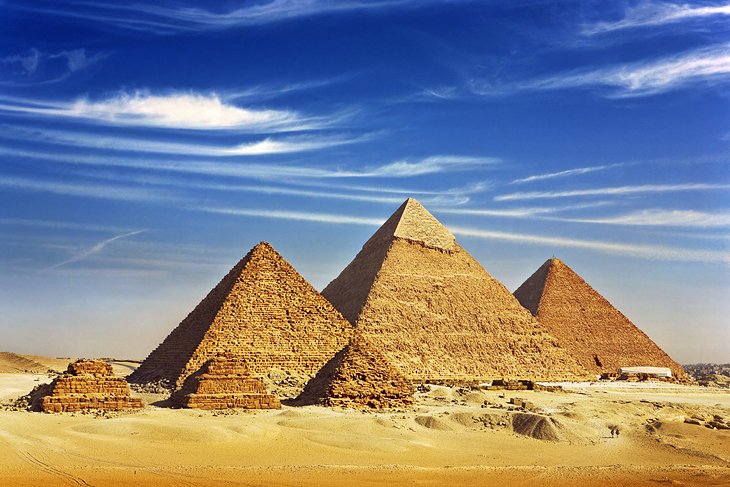
The last surviving wonder of the Seven Wonders of the Ancient World, the Pyramids of Giza are one of the world's most recognizable landmarks.
Having awed travelers down through the ages, these tombs of the Pharaohs Khufu (Cheops), Khafre (Chephren), and Menkaure (Mycerinus), guarded by the enigmatic Sphinx, are usually top of most visitor's lists of tourist attractions to see in Egypt and often the first sight they head to after landing.
Today, sitting on the desert edge of Cairo's sprawl, these megalithic memorials to dead pharaohs are still as wondrous a sight as they ever were and an undeniable highlight of any Egypt trip.
To beat the crowds , get here around 7:30am and enter through the main Pyramid of Khufu site entrance (rather than the Sphinx entrance). This means you can have finished exploring the interior tunnels and burial chambers of the Pyramid of Khufu by the time the tour buses start pulling in at 8:15am.
Most visitors limit their site visit to the three pyramids and the Sphinx, but there is plenty more to see on the Giza Plateau. If you can, reserve time to explore the funerary complexes of the eastern cemetery (on the east side of the Pyramid of Khufu). The tombs of 6th dynasty high officials Qar and Idu and the tomb of Meresankh III (who was one of Pharaoh Khafre's wives) are all open to the public.
- Read More: Pyramids of Giza: Attractions, Tips & Tours
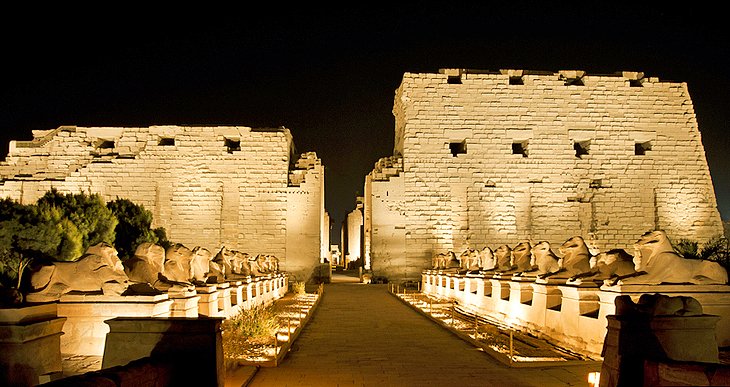
Famed for the Valley of the Kings , Karnak Temple , and the Memorial Temple of Hatshepsut, the Nile-side town of Luxor in Upper Egypt has a glut of tourist attractions.
This is ancient Thebes, the power base of the New Kingdom pharaohs, and home to more sights than most can see on one visit.
Luxor's east bank is home to the modern city, with its vibrant souq; the two temples of Karnak and Luxor; and the museum. The west bank's lush farmland and barren cliffs are where the vast majority of Luxor's tourist attractions sit, with so many tomb and temple sights that it has been called the biggest open-air museum in the world.
Spend a few days here exploring the colorful wall art of the tombs and gazing in awe at the colossal columns in the temples, and you'll see why Luxor continues to fascinate historians and archaeologists.
The Valley of the Kings is one of Egypt's most visited sites but, if you are willing to get up extra early, you can beat the crowds . All of Luxor's archaeological sites open at 6am, but hardly any visitors (and no large tour operators) take advantage of this.
Kick off your sightseeing with a 6am start at the Valley of the Kings, and you'll get to experience the interiors of Luxor's famed New Kingdom tombs with hardly anyone else (except the handful of other wily early risers) there.
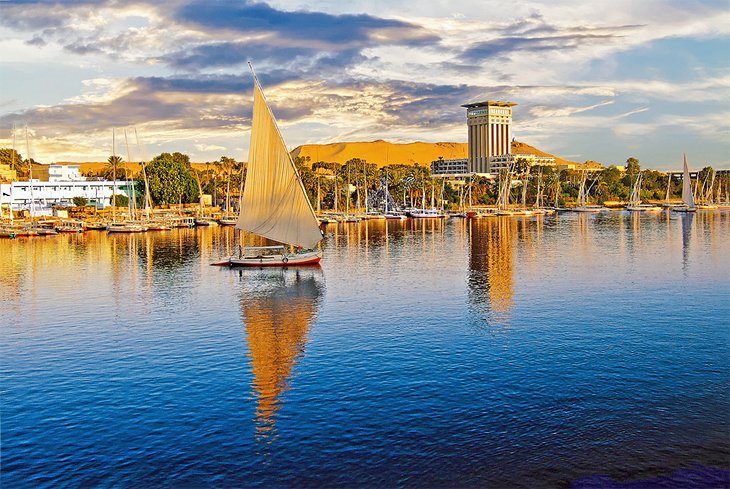
Egypt is defined by the Nile. For many visitors, a multi-day cruise upon this famed waterway that saw the rise of the Pharaonic era is a highlight of their Egypt trip.
Cruising the Nile is also the most relaxing way to see the temples that stud the banks of the river on the route between Luxor and Aswan, plus sunrise and sunset over the date-palm-studded river banks, backed by sand dunes, is one of Egypt's most tranquil vistas.
The two famous sights on a Nile Cruise are the Temple of Kom Ombo and Edfu's Temple of Horus , where all the big cruise boats stop.
If you'd prefer a less crowded and slower experience, though, and don't mind "roughing it" a bit, you can also cruise the Nile by felucca (Egypt's traditional lateen-sailed wooden boats), which also allows you to create your own itinerary.
The vast amount of cruise boat itineraries depart from either Luxor or Aswan, but feluccas can only be chartered for multi-day trips from Aswan.
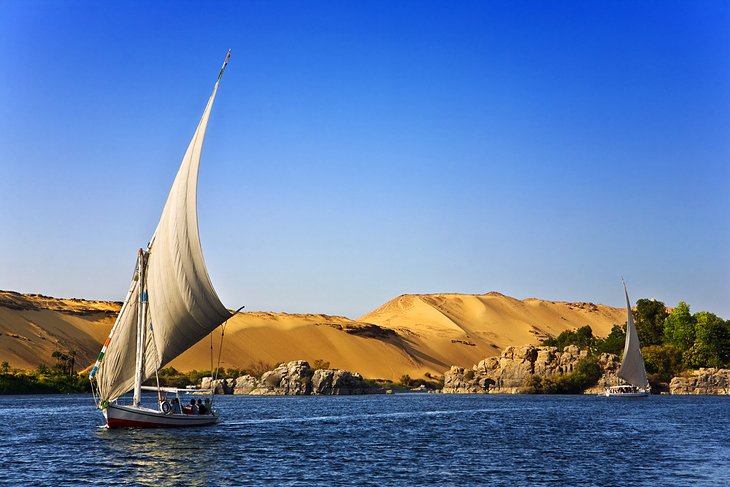
Egypt's most tranquil town is Aswan, set upon the winding curves of the Nile. Backed by orange-hued dunes, this is the perfect place to stop and unwind for a few days and soak up the chilled-out atmosphere.
Take the river ferry across to Elephantine Island and stroll the colorful streets of the Nubian villages. Then ride a camel to the desert monastery of St. Simeon on Aswan's east bank. Afterwards, relax in one of the riverboat restaurants while watching the lateen-sailed feluccas drift past.
Make sure to jump aboard a felucca at sunset to sail around Aswan's islands. This is by far, Aswan's most popular activity and the most relaxing way to take in the local sights.
There are plenty of historic sites here and numerous temples nearby, including Philae Temple on its island, but one of Aswan's most popular things to do is simply kicking back and watching the river life go by.
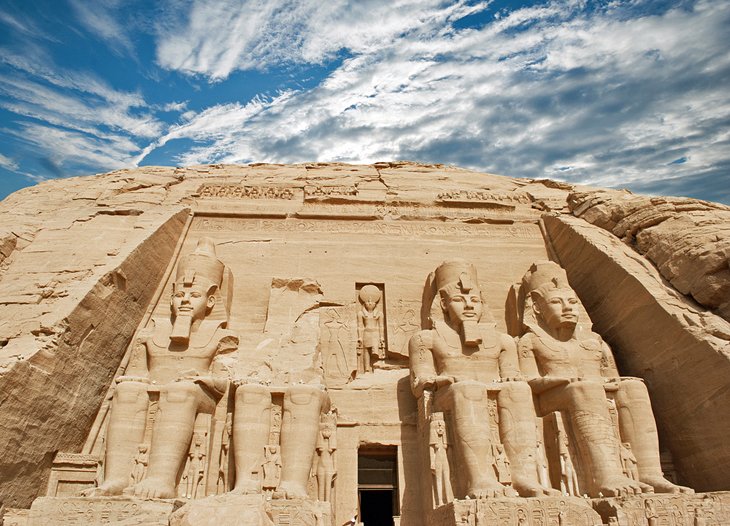
Even in a country festooned with temples, Abu Simbel is something special. This is Ramses II's great temple, adorned with colossal statuary standing guard outside, and with an interior sumptuously decorated with wall paintings.
Justly famous for its megalithic proportions, Abu Simbel is also known for the incredible engineering feat carried out by UNESCO in the 1960s, which saw the entire temple moved from its original setting to save it from disappearing under the rising water of the Aswan Dam.
Today, exploring Abu Simbel is just as much about admiring the triumph of this international effort to save the temple complex as it is about gaping in wonder at Ramses II's awe-inspiring building works, itself.
Most people arrive in Abu Simbel on organized day trips from Aswan, which all have an early morning start to get to the temple complex at 8am or 9am.
After 11am, nearly everyone has cleared out and headed back to Aswan. To wander through Ramses II's colossal monument without the crowds, overnight in Abu Simbel village itself and visit the temples after midday.
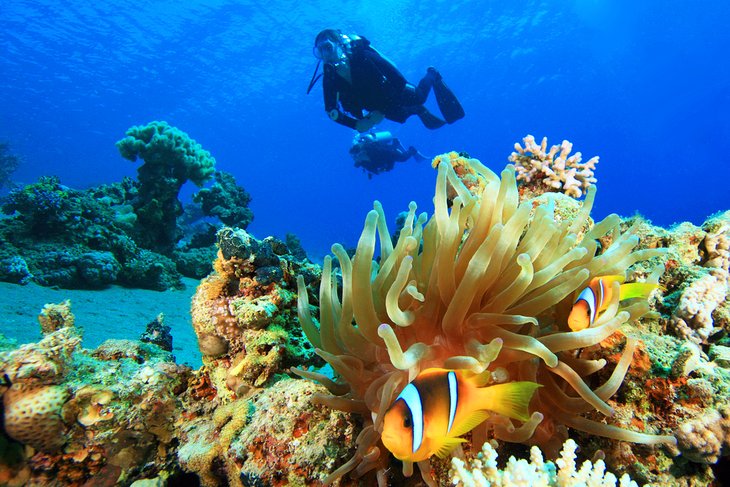
Below the Red Sea's surface is another world as fascinating as the temples and tombs on land.
The coral reefs of the Red Sea are renowned among scuba divers for both the soft corals on display and the vast amount of sea life, ranging from colorful reef fish and nudibranchs to sharks, dolphins, turtles, rays, and even dugongs.
For divers, the most famous town to base yourself in is Sharm el-Sheikh on the Sinai Peninsula, closest to the reefs of Ras Mohammed National Park, as well as the reefs of the Straits of Tiran.
To dive the sites of the Straits of Gubal head to Hurghada or El Gouna on the Red Sea coast, while advanced divers should check out the resort of Marsa Alam, the nearest base for diving Egypt's "deep south" dive sites.

As well as fish life and coral, the Red Sea is a major wreck-diving destination. The most famous wreck is the Thistlegorm, a British WWII cargo ship that was on its way to resupply Allied troops when it was bombed by the Germans in 1941.
Today the site is regarded by divers as one of the top five wreck dives in the world due to the vast cargo of cars, motorbikes, and WWII memorabilia that can be seen both scattered on the sea bed around the wreck and inside the ship itself.
Dive boat trips to the wreck are organized from both Sharm el-Sheikh and Hurghada.
The Red Sea offers year-round diving but for the calmest sea conditions and best underwater visibility, July and August are the best months . This is high summer in Egypt though with its accompanying sweltering on-land temperatures. If your Egypt trip doesn't solely revolve around diving, it's still best to avoid these months.
Read More: Diving in the Red Sea: Best Dive Sites
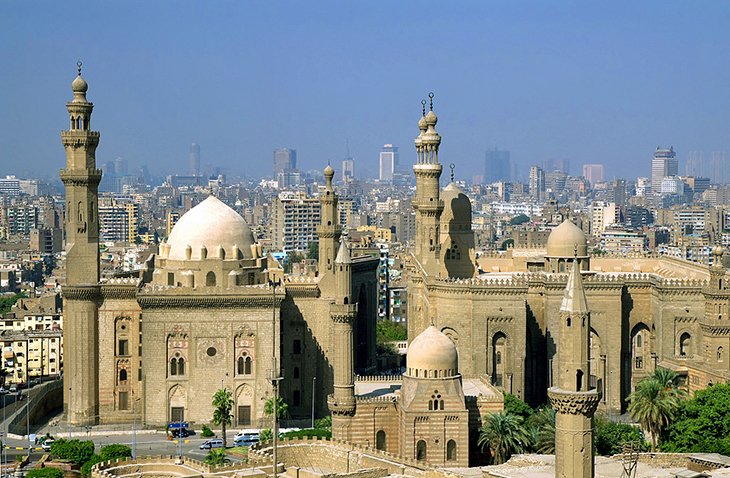
The atmospheric, narrow lanes of the capital's Historic Cairo district are crammed full of mosques, madrassas (Islamic schools of learning), and monuments dating from the Fatimid through to the Mameluke eras.
This is where you'll find the labyrinth shopping souq of Khan el-Khalili, where coppersmiths and artisans still have their tiny workshops, and stalls are laden with ceramics, textiles, spice, and perfume.
Surrounding the market is a muddle of roads, home to some of the most beautiful preserved architecture of the old Islamic empires.
There is a wealth of history here to explore. Visit Al-Azhar Mosque and the dazzling Sultan Hassan Mosque , and make sure to climb up to the roof of the ancient medieval gate of Bab Zuweila for the best minaret-speckled panoramas across the district.
Mornings are the best time to visit this district as the narrow lanes are at their quietest. If you're planning to visit the area's mosques though, avoid visiting on Fridays (the Muslim holy day) . If you want to enter mosques as a tourist, dress conservatively (covering arms and legs) and bring along a scarf to throw over your head if you're female.
Keen shoppers should head to Khan el-Khalili in the evening: the shops here are all open until late and the souq is at its most vibrant after dark.
- Read More: Top Tourist Attractions in Cairo & Easy Day Trips
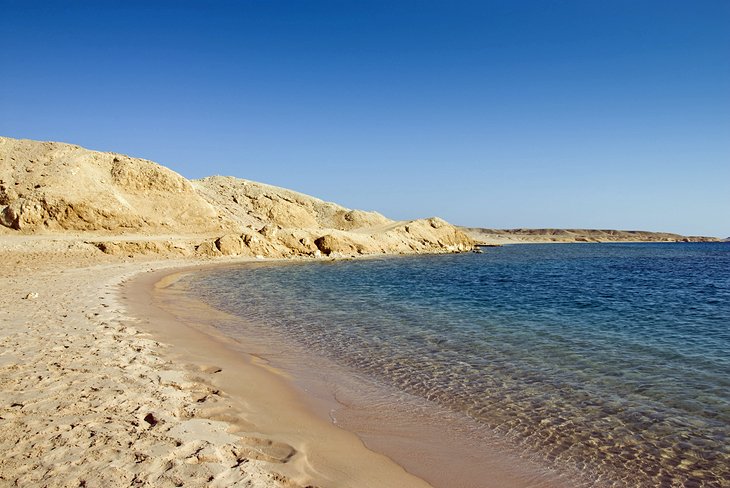
Egypt's South Sinai region, on the Sinai Peninsula, offers a beach for every type of traveler.
Sharm el-Sheikh is a European-style resort town packed full of luxury hotels, international restaurants, and bags of entertainment options. A favorite with Europeans on winter-sun vacations, many of the resorts here cater to families on one- or two-week sun-and-sand breaks.
Dahab is a low-key beach town with a budget-traveler heart, which is just as much about desert excursions and adventures as the sea. It's particularly known for its cheap dive-package deals and for its lagoon beach area where windsurfing and kitesurfing are the top activity.
Up the coast, between the port town of Nuweiba and the border town of Taba are the bamboo hut retreats that offer complete get-away-from-it-all respites from life and back-to-basics beach life.
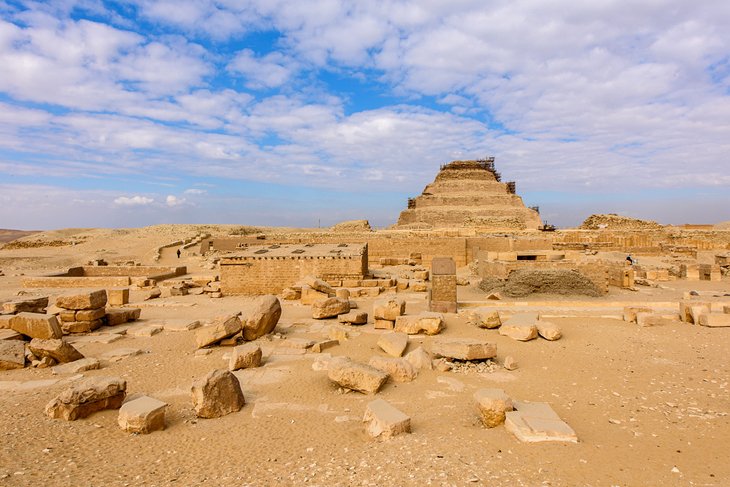
Everyone's heard of Giza's Pyramids, but they're not the only pyramids Egypt has up its sleeve. Day-tripping distance from Cairo , Saqqara is a vast necropolis of tombs and pyramids that was utilized during every era of Pharaonic rule.
It's best known for its Old Kingdom Step Pyramid, which shows how the architects of Ancient Egypt advanced their engineering knowledge to finally create a true pyramid shape.
There's much more to see beyond the Step Pyramid, though, with some of the surrounding tombs, such as the Mastaba of Ti, showcasing some of the finest tomb paintings you'll see in the country.
Nearby, the pyramid site of Dahshur is home to the Red Pyramid and Bent Pyramid, which should be included on any Saqqara visit.
- Read More: Exploring Saqqara: A Visitor's Guide
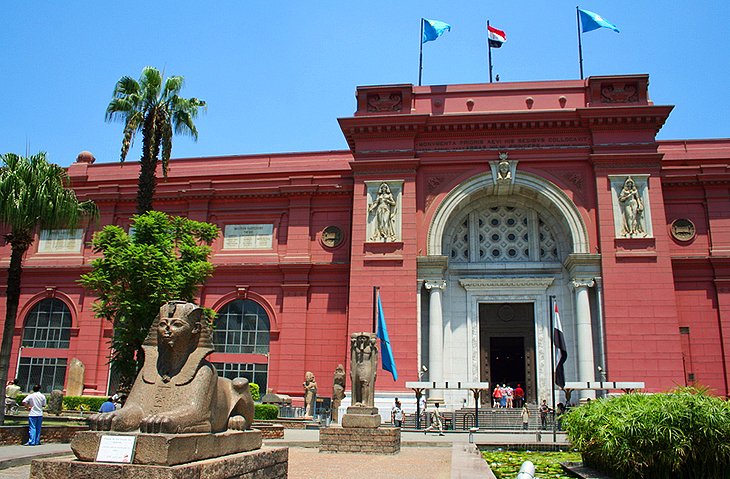
A treasure trove of the Pharaonic world, Cairo's Egyptian Museum is one of the world's great museum collections . The faded pink mansion in downtown Cairo is home to a dazzling amount of exhibits.
The museum's exhibits cover the breadth of the Pharaonic era with highlights including its artifacts from pre-dynastic Egypt, the Old Kingdom galleries displaying the fine statuary from Egypt's period of pyramid builders, and the displays of glittering funerary goods unearthed from the country's most famous tomb finds.
Make sure to reserve enough time at the museum to fully view the galleries devoted to the grave goods of Yuya and Thuya and the royal tombs of Tanis (both upstairs).
Until Giza's much-delayed Grand Egyptian Museum (GEM) opens, the Egyptian Museum is also where you come to see a selection of the riches from Tutankhamen's Valley of the Kings tomb. When the GEM finally does open, these will be moved there (and the entire Tutankhamen collection will be displayed in full for the first time).
Everything else though in the Egyptian Museum's collection will be staying in place.
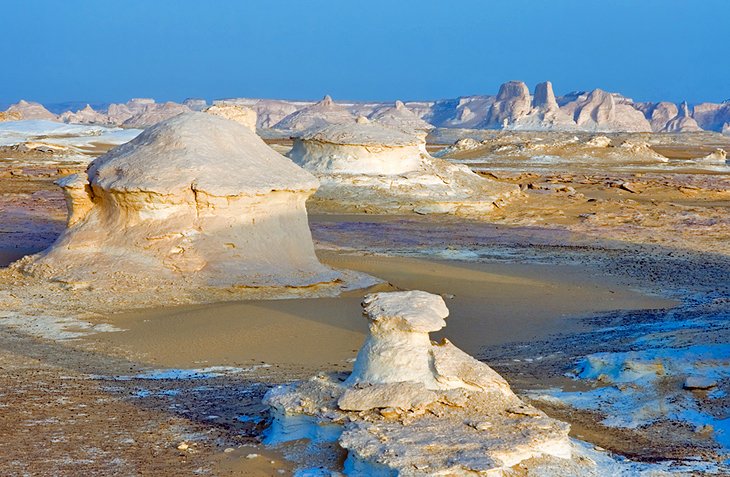
Egypt's kookiest natural wonder is White Desert National Park, out in the Western Desert, just south of Bahariya Oasis. Here, surreally shaped chalk pinnacles and huge boulders loom over the desert plateau, creating a scene that looks like icebergs have found themselves stranded amid a landscape of sand.
This highly scenic environment looks like something out of a science fiction movie and is a favorite destination for 4WD desert trips and overnight camping , which are both easiest organized in Bahariya Oasis.
For desert fans and adventurers, this is the ultimate weird playground, while anybody who's had their fill of temples and tombs will enjoy this spectacular natural scenery.
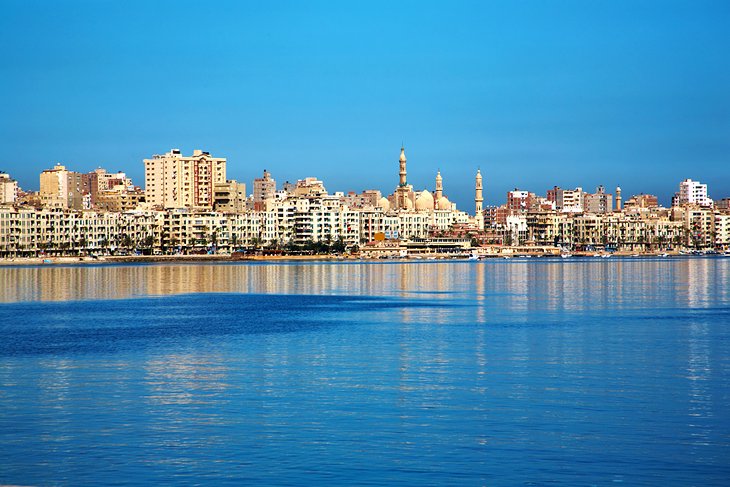
Alexandria has a history that not many others can match.
Founded by Alexander the Great, home of Cleopatra, and razzmatazz renegade city of the Mediterranean for much of its life, this seafront city has an appealing days-gone-by atmosphere that can't be beaten.
Although today, there are few historic remnants of its illustrious past left to see, Alexandria's long seafront Corniche road leading to its fort (sitting on the site where its famous ancient lighthouse once sat) remains a favorite summer destination to capture cooling sea breezes for Egyptians and foreign visitors alike.
Underwater archaeological projects here have imbued Alexandria's museums with interesting exhibits. The modern Bibliotheca Alexandrina is a contemporary interpretation of Alexandria's famed ancient library, and the handful of historic sights in town include an atmospheric catacombs site.
- Read More: Top-Rated Attractions & Things to Do in Alexandria
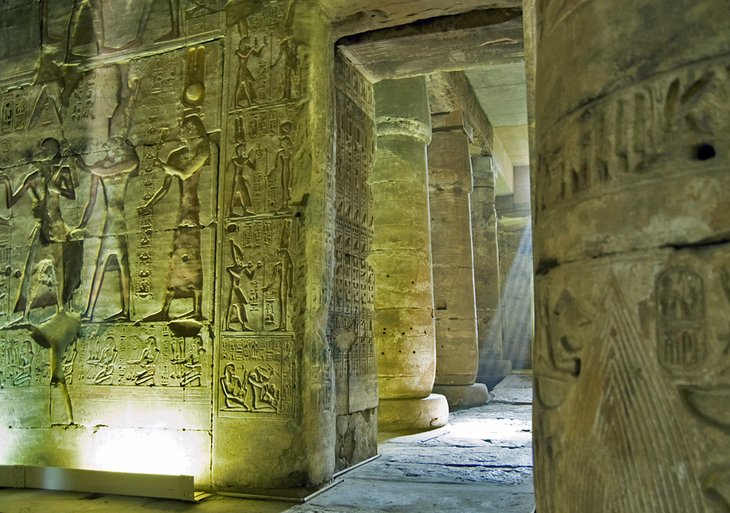
The Temple of Osiris in Abydos is one of Ancient Egypt's most fascinating artistic treasures.
The temple, begun by Seti I, sits amid a vast necropolis site where archaeological excavations are ongoing. There a various other temple remnants to see here but for most visitors, the Temple of Osiris is the main reason to visit.
Its hypostyle halls, graced by papyrus-headed columns, contain some of the finest relief-work in Egypt, with various scenes portraying the pharaoh and the gods of Ancient Egypt.
As the temple lies north of Luxor, it isn't on the main Nile cruise ship route, so it receives much fewer visitors than the temple sites in Luxor itself and the Nile-side temples to the south. This means you are often lucky enough to wander through the temple's halls with only a few other visitors on site.
- Read More: Exploring The Temples of Abydos: A Visitor's Guide
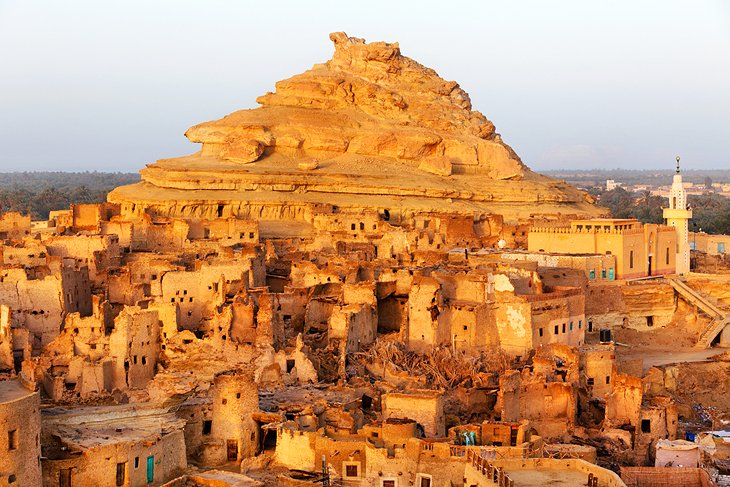
Sitting in isolation, in the western corner of the Western Desert, Siwa is the tranquil tonic to the hustle of Egypt's cities. This gorgeous little oasis, surrounded by date palm plantations and numerous hot-water springs, is one of the Western Desert's most picturesque spots.
Siwa town is centered around the ruins of a vast mud-brick citadel, known as the Fortress of Shali, which dominates the view, while various temple remnants, including the Temple of the Oracle where Alexander the Great is said to have come to receive advice, are scattered throughout the wider oasis area.
This is a top spot to wind down and go slow for a few days, as well as being an excellent base from which to plan adventures into the surrounding desert.
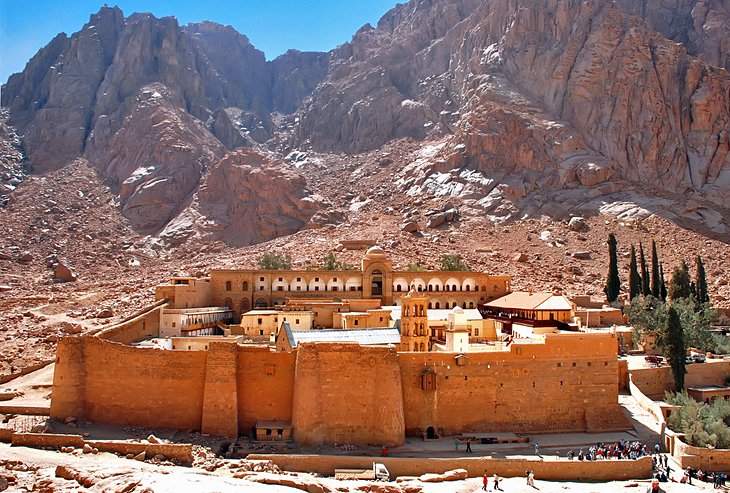
One of the oldest monasteries in the world, St. Catherine's stands at the foot of Mount Sinai, amid the desert mountains of the Sinai Peninsula, where Moses is said to have received the Ten Commandments.
This desert monastery is home to an incredible collection of religious iconography, art, and manuscripts (some of which can be seen in the on-site museum), as well as the burning bush.
For most visitors here, a trip to St. Catherine's also involves a hike up Mount Sinai to see sunrise or sunset. Take the camel path for the easy route, or climb the famous Steps of Repentance if you want better views.
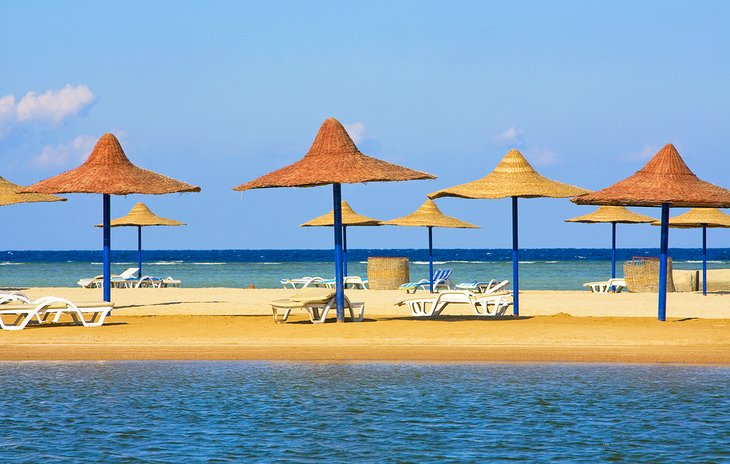
Egypt's Red Sea coastline offers swaths of sand for travelers who want a time-out from temple viewing.
During winter, the resorts scattered along the shore surrounding Hurghada jump into life as European families arrive on package tourism breaks.
The big bonus of choosing a resort on the Red Sea coast over one on the Sinai Peninsula is that you are within day-tripping distance to Luxor, so this is the best place to visit for beach life if you still want to easily see some of Egypt's most famous monuments.
Hurghada and El Gouna are the two main resort towns, while the smaller, and still being-developed, town of Marsa Alam is much farther south.
Read More: Top-Rated Tourist Attractions in the Red Sea Region
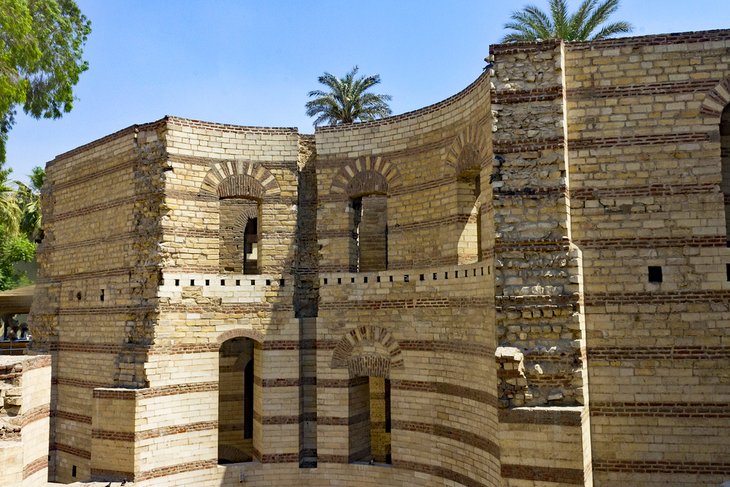
The Cairo district known as Coptic Cairo is one of the most important Christian sites in the country.
Originally the Fortress of Babylon, dating back to the Achaemenid Empire's conquest of Egypt in 525 BCE, this district is home to Cairo's oldest surviving church, synagogue, and mosque, as well as the excellent Coptic Museum, which holds the world's largest collection of Coptic Christian art and antiquities.
A section of the Fortress of Babylon's walls, which were repaired and expanded under Roman rule, are also still standing and are the entrance into the district.
Make sure to visit the Hanging Church, which holds a fine collection of icons and was built half over the Roman-era water wheel (hence the church's name). Then thread your way down the narrow alley to the Church of St. Sergius and Bacchus which, according to local tradition, was built atop the site where the Holy Family with the infant Jesus lived in refuge after fleeing King Herod.
Nearby, the Ben Ezra Synagogue is famous for being the site where the Geniza documents cache were discovered.
A short walk away is the Mosque of Amr Ibn Al As, built by the Arab Muslim army commander (and later, first governor of Egypt) after conquering Egypt.
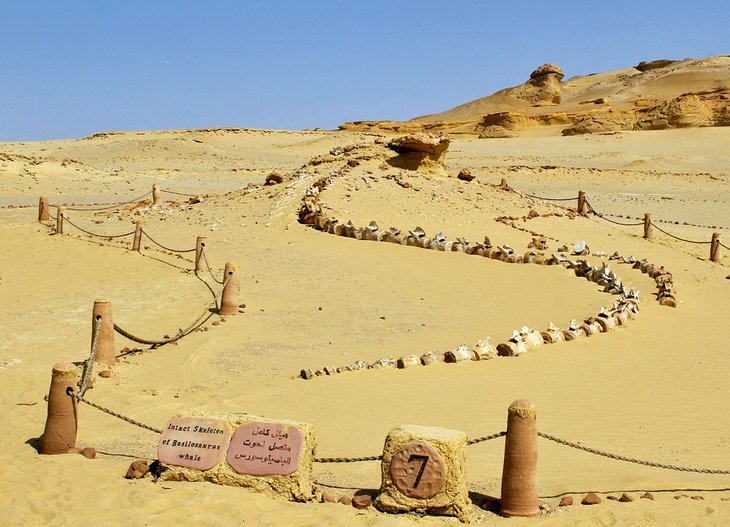
Wadi Al-Hitan is in the Fayoum area, a lush and fertile depression fed by ancient canals and surrounded by desert.
The Fayoum itself, with Lake Quran, the pottery village of Tunis, and Pharaonic ruins scattered across the hinterland, is an interesting place to visit, but the main tourist attraction here, in the nearby desert, is the UNESCO World Heritage site of Wadi Al-Hitan.
Amid the orange dunes and jagged rocks of this desert valley, a vast fossil cache of the oldest prehistoric whales (the basilosaurus and dorodontus) were discovered, hugely aiding human understanding of the evolution of whales.
Some of the finds have been kept in situ, with walking tracks radiating out from the visitor's center to skeleton sites sitting amid the sand.
In the visitor center itself, a museum dedicated to the site does an excellent job of explaining Wadi Al-Hitan's importance, and displays many of the site's other finds, including a skeleton of a basilosaurus whale that measures 18 meters long.
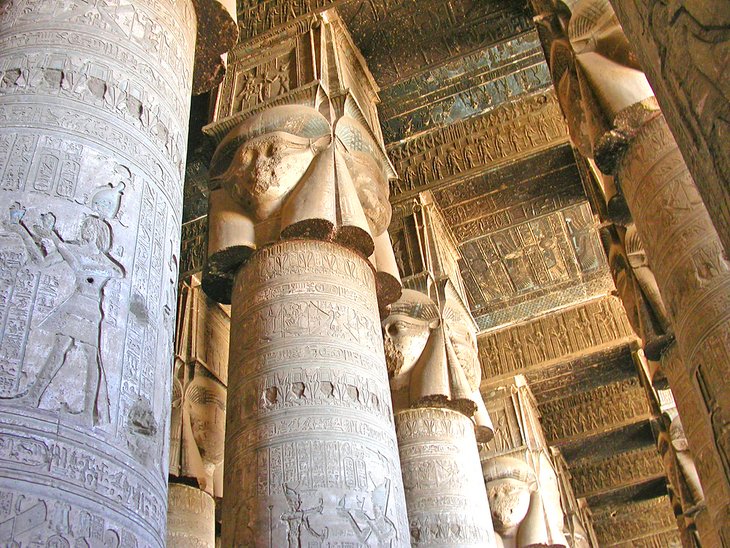
The Temple of Hathor at Dendara was built in the late Pharaonic era and extended during the Roman period, though Dendara itself was an important cult center from early on in the period of Ancient Egypt.
A trip here is well worth a day trip from Luxor, as the temple's youth (in comparison to other Pharaonic temples) means that it is one of the most complete surviving temples in Egypt.
The reliefs and decoration here are in an excellently preserved state. In particular, while in the hypostyle hall, which was built by the Roman Emperor Tiberius, note the columns topped by heads of the Egyptian god Hathor, and the wall reliefs of the emperor paying tribute to the Egyptian gods.
Dendara is just outside the city of Qena, 80 kilometers north from Luxor.
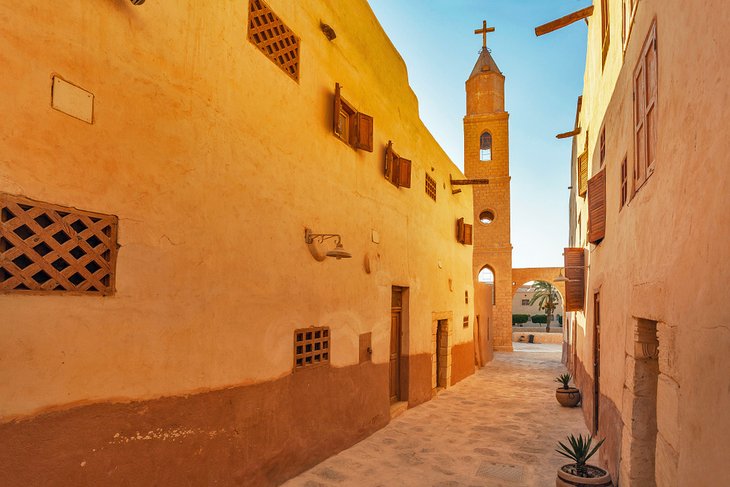
Secreted within the jagged northern mountains of the Red Sea coast, the Monastery of St. Anthony has been a working monastery since the 4th century, and today is still home to around 120 monks.
The Church of St. Anthony, within the fortress-like compound, has an interior of secco wall paintings that are considered one of the most important collections of Egyptian Coptic art in the world and date from around the 11th and 12th centuries. The church is also home to the tomb of St. Anthony (the father of monasticism) and is a major pilgrimage destination for Egyptian Coptic Christians.
Monks run tours of the monastery that include visiting the church and some of the monastery's gardens, as well as allowing you to head up and walk on top of the monastery's walls.
St. Anthony's Monastery is very isolated. If you don't have your own transport, the easiest way to get here is to hire a driver from Cairo or Hurghada.

More on Egypt
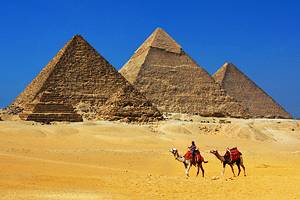
Change location
- UK / International
- Call toll-free from 9am EDT
- 617-223-4521 617-223-4780 or
- REQUEST A QUOTE
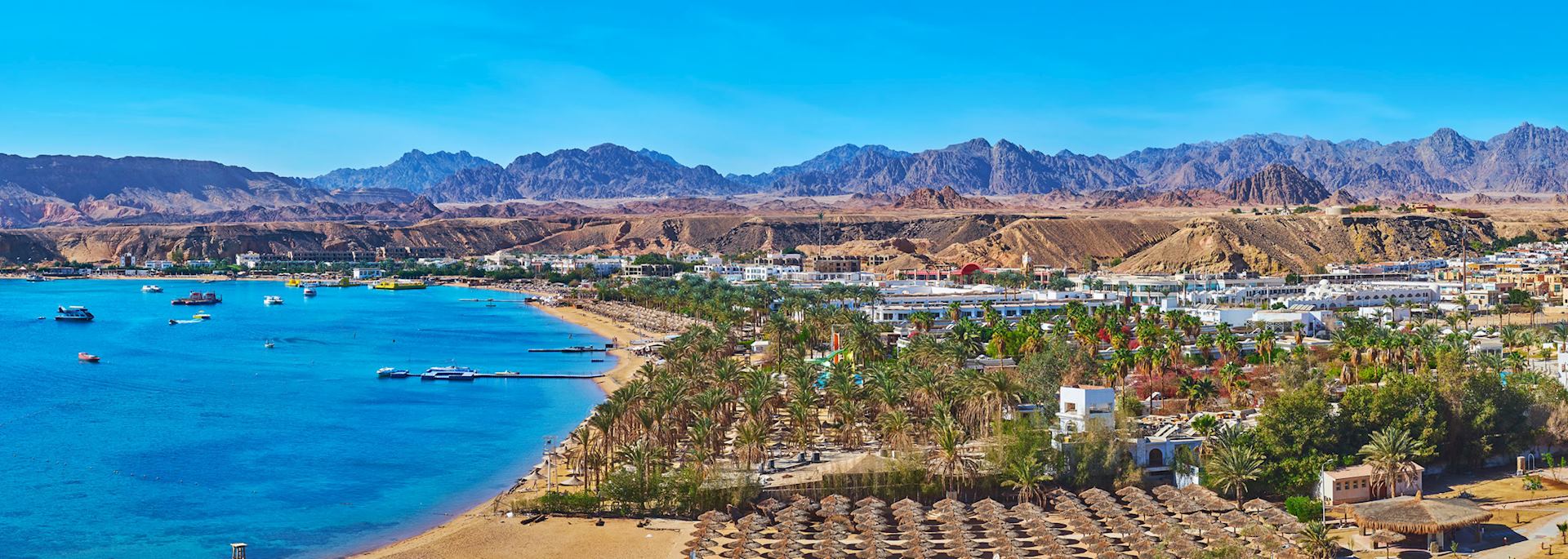
Visit the Red Sea, Egypt
- Accommodation
Since ancient times, the long, narrow Red Sea acted as a crossroads for three continents — traders and visitors passed through, but the area was primarily treated as a sea passage until the 1980s. The only exception was a small community of reef divers who jealously guarded the sea’s secret — the exceptional reef diving. This is due to a lack of storms combined with naturally high salinity, which discourages algae growth and makes the water exceptionally clear.

A sleepy, quiet town largely untouched by development, El Quseir was the biggest port on the coast before the tenth century. Today, it’s home to one of the best reef diving areas in the region, thanks to rigorous protection of the marine habitat since the 1960s. The house reef extends right up into the bathing area and your hotel will happily arrange a dive trip to the reefs further out.
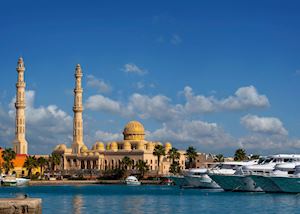
There are so many choices that you’ll want to speak with your hotel’s dive staff, who’ll be able to help you narrow down where you want to visit, depending on the conditions and weather.
Best time to visit the Red Sea
As in the rest of Egypt, the best time to visit the Red Sea is between October and April, when temperatures are usually warm enough to enjoy the beach and the water, but not uncomfortably hot. December may see the mercury dip into the low 70s °F (20s °C), but the skies will remain clear and sunny.

Start planning your tailor-made trip to the Red Sea by contacting one of our Egypt specialists
- 617-223-4521 617-223-4780
- Make an inquiry
Suggested itineraries featuring the Red Sea
Our itineraries will give you suggestions for what is possible when you travel in the Red Sea, and they showcase routes we know work particularly well. Treat them as inspiration, because your trip will be created uniquely by one of our specialists.

Cairo & the Red Sea family adventure
8 days from $5,165pp
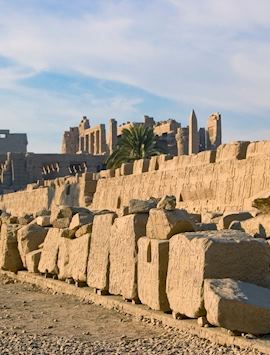
Luxury Luxor & Red Sea beaches
8 days from $5,935pp
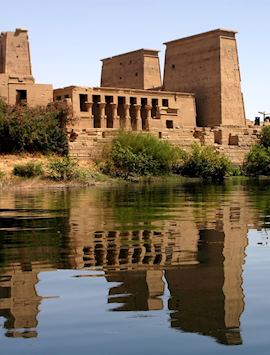
Jordan & a romantic Egyptian Nile cruise
16 days from $10,995pp
Map of the Red Sea
Places & hotels on the map, places in and around the red sea.
- El Quseir The Red Sea
- Hurghada The Red Sea
- Luxor 161 miles away
- Upper Egypt 210 miles away
- Aswan 236 miles away
- Dahshur 282 miles away
- Saqqara 286 miles away
- Cairo 295 miles away
- Giza 296 miles away
Our expert guides to exploring the Red Sea
Written by our specialists from their own experiences of visiting the Red Sea, these guides will help you make the most of your time there. We share both our practical recommendations and the best ways to appreciate the Red Sea at its best.
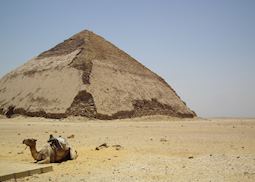
What to do in Egypt: our highlights guide
Home to some of the world's most historical monuments and best dive sites, Egypt's size makes it possible for the first-time visitor to see many of its highlights in a relatively short trip.
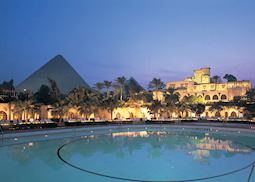
Luxury Egypt: live like a pharaoh
A room at the foot of the Great Pyramid, an opulent ship on the Nile, and private guides — Egypt specialist Emma outlines the most indulgent ways to enjoy the country’s classic sights.
Accommodation choices for the Red Sea
We've selected a range of accommodation options for when you visit the Red Sea. Our choices usually come recommended for their character, facilities and service or location. Our specialists always aim to suggest properties that match your preferences.
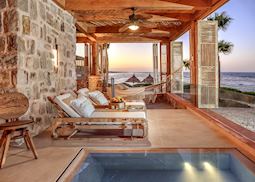
Mövenpick Resort El Quseir
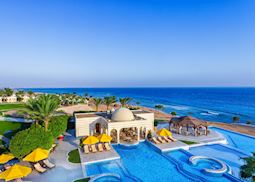
Oberoi Sahl Hasheesh
Red Sea Coast


IMAGES
VIDEO
COMMENTS
20 Top-Rated Attractions & Places to Visit in Egypt. 22 Top-Rated Attractions & Things to Do in Cairo. ... Updated Dec 25, 2023. The Red Sea is one of the world's best places to visit for scuba diving, and for decades dive enthusiasts have headed here specifically for a holiday spent mostly underwater.
5. Hurghada Marina. 4,120. Marinas. Admission tickets from $52. Starting from June 2008 Hurghada Marina Boulevard has offered Hurghada city a great opportunity to enjoy the sea breeze in a quiet, amazing place. Hurghada Marina Boulevard offers you a different …. See ways to experience (308) 2024.
Red Sea Coast. Egypt, Africa. The 'Red Sea Riviera' is a place of many different attractions. On the one hand, it is famous (or infamous, depending on your view) for cheap package holidays - overdevelopment has pockmarked the coastline deeply, leaving a trail of megaresorts and half-finished hotels in its wake.
5. Hurghada Marina. 4,120. Marinas. Admission tickets from ₹4,309. Starting from June 2008 Hurghada Marina Boulevard has offered Hurghada city a great opportunity to enjoy the sea breeze in a quiet, amazing place. Hurghada Marina Boulevard offers you a different …. See ways to experience (304) 2024.
These days Egypt's Red Sea Coast is mostly known for its sun-and-sea family holidays but this world-class diving destination is more than beach sloth resort ... The 8 best places to visit in Egypt. Sep 14, 2024 • 8 min read. From climbing the pyramids and stargazing in the desert to diving in the Red Sea, Egypt has travel experiences to spare
Egypt's Red Sea resorts are popular summer vacation destinations, but temperatures can be oppressively hot in July and August, making desert trips a test of endurance. Fall (September-November) is a great time to visit, with warm seas, sunny days, cooler nights, and fewer crowds.
Red Sea Coast. Originally an Ottoman diwan (council chamber), the once grand old police station on Al Quseir's waterfront is now a picturesque but dilapidated shell. Discover the best attractions in Red Sea Coast including Monastery of St Anthony, Monastery of St Paul, and Sha'ab Samadai.
When it comes to the best places to visit in the Red Sea, Egypt, Hurghada stands out as a must-see destination. With its picture-perfect beautiful beaches, bustling markets, and lively nightlife scene, Hurghada offers something for every type of traveler. Whether you're looking to relax on the beach, explore underwater wonders, or immerse ...
20 Top-Rated Attractions & Places to Visit in Egypt. 22 Top-Rated Attractions & Things to Do in Cairo. 18 Top-Rated Attractions & Things to Do in Alexandria. ... Colorful fish in the Red Sea at Hurghada. The best underwater sites of Hurghada's coastline can only be accessed by diving. If diving isn't for you, though, there are still plenty of ...
Aim for the umbi sharks bay port. 11. Old Market. 1,625. Flea & Street Markets. Eclectic shops line the narrow alleyways of this bustling market, trading in spices, textiles, and other traditional Egyptian goods and wares. Rub shoulders with the locals and pick out ornaments …. See ways to experience (31) 2024.
The triangular peninsula is divided from the rest of Egypt by the Suez Canal and the Red Sea. Craggy mountains, including 7500-foot Mount Sinai, plunge down to the waters of the Red Sea. Spectacular snorkeling and diving sites beckon from the Gulf of Aqaba to the east of the peninsula, particularly along the dramatic coastline of Na'ama Bay in ...
Introduction. The Red Sea has more than 2,200 km of coastline south of the Sinai Peninsula, with a width of more than 300 km and many cities built around its beaches. The best known are Hurghada and Sharm el-Sheikh. But the charm of the Red Sea does not end here but continues centuries back through the history of mankind, as with everything in ...
Best places to stay. The Red Sea area of Egypt is a popular destination for beach lovers and divers, so when it comes to choosing the best area to stay in the Red Sea, there are a few key options to consider. Hurghada . Hurghada is a bustling city with a wide range of accommodations, from budget-friendly hostels to luxury resorts. Sharm El-Sheikh
A bit further north of Soma Bay comes the largest city along Egypt's Red Sea coast on the African side - Hurghada. Hurghada is really popular with European package holiday-goers and is the second most marketed Red Sea destination after Sharm el Sheikh on the Sinai Peninsula. There are even direct flights to Hurghada from several European ...
Plan a wonderful trip with our Red Sea Coast travel guide. The most comprehensive tourist guide for Red Sea Coast, Egypt with advice on things to do and see, places to visit and more. Insight Guides provides inspiration for travelling around the world. ... The Best of Egypt. 8 days from 1999 USD. see all trips. Your advantages of booking with ...
Expedia Red Sea is a Adventure and Organized trips, Travel and Tours company in Egypt that provide guests with activities and excursions with multi language and high quality service and standards. our team consist of four and we are an agents for tours and excursion operators in Egypt.
Diving is top of most travelers' things to do list on a Red Sea trip, and Egypt is home to the best of the Red Sea's dive sites. The underwater tourist attractions of Ras Mohammed National Park and the eerie wreck of the Thistlegorm are world-renowned and remain among the best places to visit for keen divers, but there are many more underwater highlights off Egypt's Red Sea coastline.
Here is our pick of the 8 best places to visit in Egypt. 1. Cairo. Egypt's bustling capital city is layered with cultural, religious, architectural and even culinary history. Its wonders stretch far beyond the walls of its famous museums - you can take in centuries worth of sights just by walking down the city streets.
Elphinstone Reef. atese / Getty Images. Address. Al Qusair - Marsa Allam Rd, Egypt. Get directions. Phone +20 10 94872011. Located approximately 6.5 nautical miles from shore, near the resort town of Marsa Alam, Elphinstone Reef is one of the highlights of the southern Red Sea.
Egypt's Red Sea coastline offers swaths of sand for travelers who want a time-out from temple viewing. During winter, the resorts scattered along the shore surrounding Hurghada jump into life as European families arrive on package tourism breaks. ... 24 Best Places to Visit in the United States. 28 Top-Rated Tourist Attractions in the World. 22 ...
As in the rest of Egypt, the best time to visit the Red Sea is between October and April, when temperatures are usually warm enough to enjoy the beach and the water, but not uncomfortably hot. December may see the mercury dip into the low 20s °C (70s °F), but the skies will remain clear and sunny. Read more. 01993 838 410.
Best time to visit the Red Sea. As in the rest of Egypt, the best time to visit the Red Sea is between October and April, when temperatures are usually warm enough to enjoy the beach and the water, but not uncomfortably hot. December may see the mercury dip into the low 70s °F (20s °C), but the skies will remain clear and sunny.
Where to go, best places to stay, travel tips and and best holiday destinations - inspiration from the experts at Lonely Planet. Lonely Planet. Destinations. Planning. Inspiration. Shop. Search. Saves. Open main menu. Red Sea Coast. Egypt, Africa.